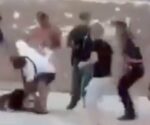I survived chamber of horrors with hidden mass grave of 796 children | World | News
Almost 800 children are believed to be buried in an unmarked mass grave in what can only be described as horrific..
The devastating details of Ireland’s secret burial site were brought to light in 2014, when local amateur historian, Catherine Corless, uncovered the terrifying truth.
At least 796 children are believed to have been buried in Tuam, County Galway, in the west of Ireland, in what was potentially a septic sewage tank. The mass gravesite’s excavation will begin on Monday, July 14, in the hopes that it will lead to the identification of those buried there.
The burial site was once the St Mary’s Mother and Baby Home – a church-run institution, operated by nuns from the Bon Secours order – that housed thousands of women and children between 1925 and 1961.
The Home, as it came to be known, took in unmarried pregnant women and separated them from their children after birth. The children would then be offered up for adoption, oftentimes in the US.
Enda Kenny, former Taoiseach (Irish prime minister), dubbed the home a “chamber of horrors”. And rightly so.
One such survivor of this chamber of horrors is PJ Haverty, who spent the first six years of his life in the home which he calls “a prison”. His birth mother had been taken to St Mary’s by a priest who had made it clear she was no longer allowed in the church because she was a sinner.
A year after giving birth to PJ, his mother was told to leave the home — as well as her baby.
Speaking to the BBC, PJ shared: “I got out of there. You were dirt from the street, because you were born out of wedlock. It’s so sad that the likes of me and my mother had to be punished. We had to go [to school] 10 minutes late and leave 10 minutes early, because they didn’t want us talking to the other kids. Even at break-time in the school, we weren’t allowed to play with them – we were cordoned off.”
Years later, PJ reunited with his mother, with both bearing deep scars from their past.
Unfortunately, PJ was only one of 3,349 children who lived at the home during the 36 years of its operations. And all of this was a secret until 2014, when local historian Catherine Corless shone a light on the home’s dark past. Having actually gone to school with kids from the home, Catherine remembered them being extremely emaciated. In horrific statistics, it’s believed a child died at the home every two weeks.
Anna Corrigan, who believed well into her 50s that she was an only child, eventually found out she had two brothers, at least one of whom died in the home. Speaking to reporters outside the gravesite recently, Anna said: “We never thought this day would come. They got no dignity in life and they got no dignity in death, so hopefully their voices are heard because I think they’ve been crying for a long time to be found.”
In 2017, Catherine’s discoveries were validated when an Irish government investigation uncovered “significant quantities of human remains” during a test excavation of the site. The remains were of children ranging in age from approximately 35 foetal weeks to two or three years.
Experts from Britain, Spain, the US, Colombia, Canada, and Australia have joined Irish specialists for the excavation. The full work is expected to take around two years, as people hold their breaths over what will be uncovered. Between 20 to 30 people are expected to be working on the excavation site at any one time.
Daniel MacSweeney, the director of authorised intervention at Tuam and the excavation’s head of operations, told the BBC: “It’s a very challenging process – really a world-first. They’re absolutely tiny. We need to recover the remains very, very carefully — to maximise the possibility of identification.”
Although it’s been only 64 years since the horrific institution at Tuam closed, its impact will be felt for generations to come.









